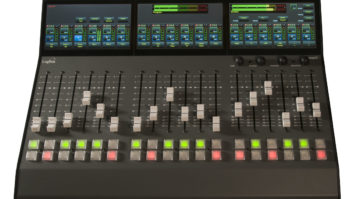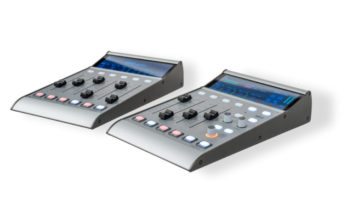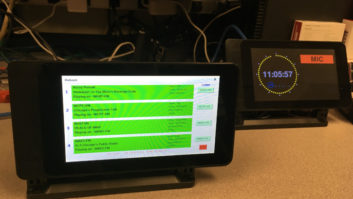Gigabit Ethernet
Dec 1, 2001 12:00 PM, By Kevin McNamara, CNE
In 1998, the IEEE adopted the standard defining one Gigabit (1Gb)Ethernet over fiber optic cabling. In June of 1999, the standarddefining 1 Gigabit Ethernet, or 1000BaseT, over copper pairs wasratified.

The Gigabit Ethernet standard for operation over CAT-5 cabling, alsoknown as IEEE 802.3ab, provides a seamless upgrade path from earlierversions of copper-based Ethernet. It supports such features as fulland half duplex operations, the 802.3 Ethernet frame format and theCSMA/CD access method. The specification adopted for Gigabit Ethernetover fiber cabling is called 802.3z or 1000BaseX.
How is it possible to get the Gigabit rate over CAT-5 cabling? Youmay recall that 100BaseT Ethernet achieved higher throughput by usingthree-level binary encoded symbols sent at a rate of 125Mbaud acrossthe cable. In addition, signals used separate pairs for transmit andreceive, permitting full-duplex transmission capabilities. GigabitEthernet was developed as an extension to 100BaseT and uses the same125Mbaud symbol rate; however, it uses five-level binary symbolsoperating over all four pairs of cabling. Each pair is also capable oftransmitting and receiving simultaneously.
Network equipment supporting 1 Gigabit Ethernet, copper and fiber,is becoming available off the shelf. Fortunately, the network equipmentdesigned to handle Gigabit Ethernet will also support earlierstandards, such as 100BaseT and 10BaseT, so for a few extra dollars itis a wise investment to begin purchasing network hardware that willsupport the new standard, even if there are no current plans to upgradethe network infrastructure. Such an upgrade may make sense for severaladditional reasons.
- Higher-speed/more efficient networks can be built using existingcabling.
- There is no need for additional training of technical staff.
- Minimal disruption to the existing network is required.
- Copper cabling is the lowest cost method to deliver GigabitEthernet.
Why upgrade?
The answer to this question depends on the needs and objectives ofthe organization. The underlying theory is that the primary backboneprovides a large pipeline to which data flows to/from one location toanother. The size of this pipeline must be large enough to allow theunrestricted flow of data from the maximum amount of simultaneoususers. In the classic client-server computing model, the networkprovided an efficient means to transfer files, share resources andaccess the Internet, but the actual processing of information tookplace on the desktop. Trends such as real-time multimedia content,storage area networking and remote application servers are placingdemands on networks. In that same client-server model, workstations areconnected to hubs, which are, in turn, connected to other hubs (orswitches), etc. At some point, all of the data from these points willappear on the network backbone. Maintaining the proper bandwidth ofthis backbone and other portions of the network infrastructure isnecessary for efficient operation. Gigabit Ethernet provides a means toincrease the overall data throughput capabilities of a network atminimal cost.
Whether you plan to upgrade to Gigabit Ethernet now or in thefuture, there are some issues of which to be aware.
Cabling
One of the best features of the Gigabit Ethernet standard is that itwill operate over existing CAT-5 cabling, assuming that the cabling andinstallation practices meet or exceed the standard defined inTIA/EIA-568A. In practice, this shouldn’t be a problem if the cablingwas installed within the past six years and tested in accordance with568A, adopted in 1995. Most cabling systems, currently operatingproperly at the 100BaseT rate should pass Gigabit Ethernet; however,the higher demands placed on the cabling operating at the gigabit ratemay show problems that were passable at 100BaseT. Each existing cablespan should be tested using a cable analyzer suitable to certifyoperation for the new Gigabit standard. In particular, each cable spanshould be tested for return loss and Equal Level Far EndCrosstalk (ELFEXT) (see September 2001 Networks) based on the1000BastT specification. Most current cable analysis tools can beupgraded to conform to the latest specifications through a softwaredownload or by purchasing a hardware module.

If plans call for the installation of new cabling, consider usingthe new generation of cable that conforms to the new CAT-5especification. The specification for CAT-5e cabling is similar to thatof CAT-5, except that it is required to meet more stringent performancerequirements for return loss and ELFEXT. Several manufacturers alsooffer cabling meeting the more enhanced CAT-6 and -7 pre-standardcabling products, which permit transmission of data at speeds in excessof 600MHz.
In all cases, maximum length of cabling per segment is at 100meters, as specified in the TIA/EIA-568-A standard.
Upgrade paths
Network upgrades should be performed at the top-most levels of theinfrastructure, typically the level that handles the largest amount ofaggregated data traffic, such as switch-to-switch or switch-to-router.Some possible scenarios follow.
Switch-to-switch
Upgrading from 100BaseT to Gigabit Ethernet switches would permitmore switched and shared segments. This is beneficial for networks thatcarry large amounts of multimedia or streaming content.
Switch-to-server
Facilities that maintain high performance and multiple servers thatprovide multimedia content, high availability to users, and complexdatabase, graphical and scientific function, would benefit from anupgrade to Gigabit Ethernet from the servers to the network switch.
Switch-to-hubs/routers
In a switched network environment, upgrading hubs (or workgroupswitches) and routers to Gigabit Ethernet would increase the overallbandwidth, number of available segments and the total amount of nodesper segment.
User-to-hub (switch)
An upgrade would permit increased speed between high-performanceworkstations and Gigabit network infrastructure.
Backbone
Buildings and campuses are typically interconnected via high-speedbackbone using fiber (or wireless) media. Backbones using fiber, orFDDI, can be upgraded either through replacement of existing FDDI hubsto Gigabit Ethernet switches or through the addition of an FDDI switchthat can be interfaced directly into Gigabit Ethernetinfrastructures.
Kevin McNamara, BE Radio’s consultant on computertechnology, is president of Applied Wireless Inc., New Market,MD.
All of the Networks articles have been approved by the SBECertification Committee as suitable study material that may assist yourpreparation for the SBE Certified Broadcast Networking Technologistexam. Contact the SBE at (317) 846-9000 or go towww.sbe.orgfor moreinformation on SBE Certification.







